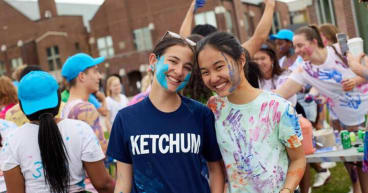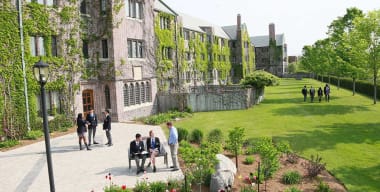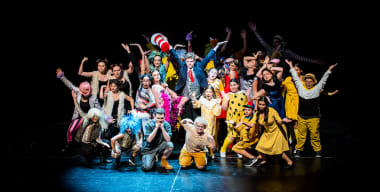Choosing a school for a physically active child
Exploring a physically active child's school fit
Kids vary widely in their physical activity level: while some are very active, others aren’t. Don’t underestimate the importance of your child’s activity level on school choice: it can play a big role in finding the right fit.
Very physically active kids are highly energetic. They like to move around a lot inside the classroom and out.
Below, we identify key points you should reflect on when considering 10 different school types for your very physically active child. Note: our aim isn’t to tell you whether a school type is right or wrong for you, but to highlight some critical factors you should consider when making your decision.
To learn about how to choose the right school in general, read the Our Kids’ step-by-step advice guide and our expert tips. To get school-choice advice customized to your child's unique traits, create a child profile through your user account and read our seven ways to choose a school based on your child's needs (i.e., overall fit, more academic challenge, social struggles, academic struggles, intensive learning interests, university preparation, and special needs.).
Very physically active kids’ fit in 10 school types
On this page:
School size
Gender
Curriculum
Living arrangements
School size
Big school (151+ students)
Big schools tend to provide an especially wide range of opportunities for your physically active child to use their energy in productive ways, such as individual and team sports, hiking, and nature walks. In most big schools, they’ll also be given plenty of breaks throughout the day for physical and gross motor activities, such as outdoor recess in the playground. Since different kids enjoy different kinds of physical pursuits, find out exactly what activities a school offers, both in class and out.
Also, ensure a school’s teaching and learning approach is suitable for your active child. “For instance, a school focusing on individual learning instead of group learning may or may not play into your child’s strengths,” say Ann and Karen Wolff of Wolff Educational Services. “You want to make sure the social, emotional, and academic realities of the classroom are a match for your child’s personality and energy level.”
Small school (150 students or less)
If you’re considering a small school for your physically active child, ensure it offers plenty of unstructured social time, such as outdoor recess, during which they can let loose. Since some small schools have fewer supplementals, you should also ask about after-school activities like sports and dance, which can give your child more opportunities to channel their energy in useful ways. Since different kids enjoy different physical activities, ask school staff what’s available, what your child is eligible for, and how they can get involved.
Gender
Coed school
In a coed school, your child can participate in a wide range of physical activities with boys and girls, from sports to nature walks to capture the flag. This can enable them to broaden their horizons and skill set by learning from the perspectives and behaviour of boys and girls. As one parent told us: “My son really enjoyed spending time and playing with boys and girls in school, which he rarely does outside of class. He also learned a lot about how girls and boys sometimes react differently in certain situations.”
Of course, coed schools require your child to negotiate the complexities of boy-girl interactions, which is challenging and can lead to inhibition, distraction, and other issues. Also, sometimes they have gender-stereotypical segregation in the selection of activities—for instance, more boys may participate in sports than girls, and more girls may participate in dance than boys—which can make some kids reluctant to take part in certain physical activities. To gauge whether your child is the right fit, ask a school what its student culture is like, especially its boy-girl dynamic.
Girls' school
Girls’ schools enable your daughter to participate in physical activities in an environment less shaped by gender stereotypes and false narratives such as “boys are better than girls at sports.” In fact, various studies conducted by the National Association for Choice in Education show that girls, in a girls-only environment, are more likely to seek out and excel in traditional boy-centric activities, such as sports. That said, since your daughter won’t be learning with boys, aim to give her many opportunities to interact with them outside of school, so she can gain a wider scope of social experiences, where she’ll learn from the perspective of girls and boys.
Boys' school
Since they tend to cater to high-energy boys, most boys’ schools provide plenty of time for your active son to stretch his legs and move around. These schools normally have an especially wide range of physical activities, such as team and individual sports, to help your son channel his abundance of energy. “In an all-boys environment, boys learn to harness their energy in appropriate social ways, which will serve them well in the schoolyard, classroom, and beyond,” say Ann and Karen Wolff of Wolff Educational Services.
Also, many boys' schools have a special focus on group and experiential learning, which your outgoing son may find engaging and stimulating. Inquire about this, and ask specific questions about a school's approach to personal, social, and academic development. For instance: How do you encourage boys to become more responsible and accountable? And, how do you help them with their organizational skills?
Curriculum
Montessori school
If you’re considering a Montessori school for your active, energetic child, make sure to look into the amount of unstructured social time provided. Some Montessori schools don’t have recess, and may limit free play, which is when young kids tend to be most physically active. While Montessori environments give kids plenty of time to interact inside the classroom, a very active child might find a lack of unstructured time challenging to cope with. Note: The more “orthodox” the Montessori environment, the more it tends to limit recess and unstructured playtime.
Language immersion school
If you’re considering a language immersion school for your active, energetic child, make sure to look into the amount of unstructured social time provided. The challenging curriculum of these schools—which requires students to learn all or most of their subjects in a second language—makes it especially important for your child to have time throughout the school day to get outside, stretch their legs, and let loose. Make sure you also find out what activities are offered after school, such as sports and dance, which can provide physical outlets for your active child.
Reggio Emilia school
Through extensive group work, projects, and activities, Reggio Emilia schools provide the kind of social and dynamic environment many physically active kids thrive in. Since Reggio educators believe children learn well through social interaction, they’re given plenty of time to interact, play, and explore their environment together.
Some Reggio Emilia schools also have a nature focus, which can enable your active child to get outdoors, learn about their surroundings, and take part in activities like gardening. Note: since Reggio schools aren’t based on a strict and unified set of principles, be sure to ask any prospective school about its focus on nature, the outdoors, and physical activity in general.
International Baccalaureate school
Throughout the continuum—from the Primary Years Programme to the Diploma Programme—the IB offers plenty of group work, projects, and activities, which can be great for physically active kids, who tend to dislike sitting down at desks all day and often enjoy social and collaborative learning. Given the demanding curriculum and heavy workload of the IB, ensure any prospective school has ample unstructured social time, so your child can get out, stretch their legs, and use their energy in productive ways. Also, ensure there are a wide range of social and physical opportunities at the school, including the ability to interact with different peer groups, both inside of class and out.
Living arrangements
Boarding school
At a boarding school, your physically active child will enjoy interacting with different peer groups drawn from a large student body. Through a wider range of supplementals—such as sports, hiking, and nature clubs—they’ll have the opportunity to feed off the energy of others in a dynamic and active environment.
Keep in mind, though, “Being active and social can be a catalyst for getting involved in lots of physical activities, which can sometimes be hard to manage,” says Joanne Foster, Toronto-based education consultant and author of ABCs of Raising Smarter Kids. “For instance, a particularly energetic child may try to end up juggling too many activities. While they still may thrive at a boarding school, it helps to know your child and how much physical activity they can handle comfortably.”
Very physically active kids’ school fit: key take-homes
- Most big schools provide an especially broad scope of opportunities for your physically active child to use their energy in productive ways, such as through individual and team sports. Since some smaller schools have fewer supplementals, ensure a prospective school offers plenty of unstructured social time and after-school activities to fulfill your child’s need to be active.
- While coed schools normally have plenty of physical activities, sometimes they have gender-stereotypical segregation in activity selection—for instance, more boys may participate in sports than girls, and more girls may participate in dance than boys.
- Since they tend to cater to high-energy boys, most boys’ schools provide loads of time for your active son to channel his energy in productive ways.
- Since some Montessori schools don’t have recess, and may limit free play, make sure to look into the amount of unstructured social time a school provides.
- Since Reggio Emilia educators believe children learn best through social interaction, your child will be given lots of time to interact, play, and explore their environment with others.









